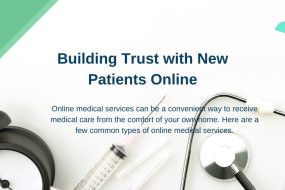
The health care practice should face a basic challenge: Should you focus on your resources to attract new patients or keep people already present? Although both patient collections and patient retention practices are crucial to development, understanding their specific roles and effects can help you make more decisions to invest time and budget.
This broad guide examines the significant difference between the acquisition and storage of patients, and examines the costs and benefits of each approach, and provides you with an actionable strategy to help create a prosperous health care system.
Understanding Patient Acquisition
Patient acquisition refers to the process of attracting new patients to your healthcare practice. This involves marketing efforts, referral programs, and outreach activities designed to expand your patient base and increase practice visibility.
The Benefits of Patient Acquisition
New patients bring fresh revenue opportunities and help practices grow beyond their current capacity. They also provide valuable diversity in your patient mix, potentially introducing new conditions, treatments, and revenue streams that can strengthen your practice’s financial foundation.
Patient acquisition strategy becomes particularly important when you’re launching a new practice, expanding into new specialties, or entering new geographic markets. It’s also crucial for replacing patients who naturally leave due to relocation, insurance changes, or other life circumstances.
The Challenges of Patient Acquisition
To attract new patients requires significant investments in marketing, advertising and promotional activities. The competition for new patients has intensified, not only with local suppliers, but also with telecommunications health services and health clinics.
Changing the opportunities in real patients often seems to be time and more touch points. Potential patients may research several suppliers, read reviews and make recommendations before making their final decision. This extended decision -making process can make patient collection operations expensive and resource intensive.
Understanding Patient Retention

Patient retention focuses on keeping existing patients engaged with your practice and encouraging them to return for ongoing care. This involves delivering exceptional patient experiences, maintaining strong communication, and building long-term relationships that foster loyalty.
The Benefits of Patient Retention
Retired patients produce more approximate income streams and usually require less marketing investments than receiving new patients. They are more likely to follow treatment plans, refer to friends and family and provide positive reviews that can promote practice reputation.
For a long time, patients develop confidence in your suppliers, leading to better health cultures and high patient satisfaction points. They understand your practice processes, establish relationships with your employees and more likely to plan preventive care trips.
The Challenges of Patient Retention
Maintaining patient loyalty requires consistent effort across all touchpoints. Patients have high expectations for convenience, communication, and care quality. A single negative experience can prompt them to seek care elsewhere, especially with the abundance of healthcare options available.
Patient retention also demands ongoing investment in staff training, technology upgrades, and process improvements. Practices must continuously evolve to meet changing patient expectations and preferences.
Patient Acquisition vs Patient Retention: Key Differences
Cost Considerations
Patient acquisition typically costs five to seven times more than patient retention. Marketing campaigns, advertising spend, and promotional offers add up quickly when you’re competing for new patients. Meanwhile, retention efforts like follow-up calls, patient education materials, and loyalty programs often cost less while delivering higher returns.
Time Investment
Acquiring new patients involves lengthy processes including lead generation, appointment scheduling, initial consultations, and relationship building. Patient retention focuses on maintaining existing relationships, which requires less time per patient but demands consistent attention to service quality.
Revenue Impact
New patients provide immediate revenue boosts and expansion opportunities. However, retained patients generate higher lifetime value through repeat visits, additional services, and referrals. They also tend to be less price-sensitive and more willing to invest in comprehensive care plans.
Measurability
Patient acquisition metrics are often easier to track, with clear numbers around new patient appointments, conversion rates, and marketing ROI. Patient retention metrics require longer-term analysis but provide deeper insights into practice health and sustainability.
Strategies for Effective Patient Acquisition
Digital Marketing Excellence
Build a strong online presence through search engine optimization, social media engagement, and targeted advertising. Ensure your website provides clear information about services, locations, and appointment scheduling options. Patient testimonials and educational content can help establish credibility with potential patients.
Community Engagement
Participate in local health fairs, sponsor community events, and offer educational workshops. Building relationships with local businesses, schools, and organizations can generate referrals and increase practice visibility.
Referral Programs
Develop formal referral programs that reward existing patients for bringing in new patients. Make the referral process simple and ensure both the referring patient and new patient receive value from the arrangement.
Read our latest blog Patient Acquisition Strategies
Strategic Partnerships
Build relationships with other healthcare providers, insurance networks, and community organizations. These partnerships can provide steady referral sources and help you reach patients who might not find your practice through traditional marketing channels.
Strategies for Effective Patient Retention
Exceptional Patient Experience
Focus on every aspect of the patient journey, from initial phone calls to post-appointment follow-up. Train staff to be responsive, empathetic, and professional. Minimize wait times and streamline administrative processes to reduce friction points.
Communication Excellence
Implement regular communication touchpoints including appointment reminders, test results notifications, and wellness check-ins. Use patients’ preferred communication methods, whether that’s phone calls, text messages, or email.
Personalized Care
Remember important details about patients’ lives, health concerns, and preferences. Use electronic health records to track patient history and ensure continuity of care across visits. Personalized attention helps patients feel valued and understood.
Convenience Features
Offer online appointment scheduling, telehealth consultations, and flexible payment options. Extended hours, same-day appointments, and multiple location options can also improve patient satisfaction and loyalty.
Finding the Right Balance
The most successful health practice does not choose between patients’ procurement and storage – they develop integrated strategies that meet both needs. The correct balance depends on the current status, development goals and available resources in your practice.
Expansion of new practice or new markets may require prioritization of procurement to create a stable patient base. Established practice can benefit from more than retention -focused strategies that maximize the value of existing conditions.
Also consider lack of your practice ability. If you are already working with full capacity, the benefit effort can provide better returns than procurement that can lead to the quality of planning difficulties and compromise.
Measuring Success in Both Areas

Track key performance indicators for both acquisition and retention efforts. Acquisition metrics might include new patient appointments, cost per acquisition, and conversion rates from marketing campaigns. Retention metrics could focus on patient satisfaction scores, appointment show rates, and patient lifetime value.
Regular analysis of these metrics helps you identify which strategies are working and where adjustments are needed. Use patient feedback, staff observations, and financial data to guide your decision-making process.
Learn about How to Attract New Patients to Your Clinic
Building a Sustainable Growth Strategy
Successful health practice believes that patients work together to obtain procurement and storage to create permanent growth. New patients provide the basis for expansion, while maintained patient ensures long -term stability and profitability.
Begin by assessing your current patient base and identifying areas of improvement. Do you lose patients due to service problems that can be solved through storage strategies? Are you missing opportunities to reach new patients in your community?
Develop a comprehensive plan that addresses both procurement and storage requirements. Take resources based on specific goals and obstacles to your practice. Remember that both efforts require continuous commitment and continuous improvement.
Health services Landscape continues to develop, with new techniques, payment models and expectations of the patient who shapes the industry. Excellent practice when it comes to receiving and maintaining patients will be best deployed to bloom in this changing environment.


















No Comments